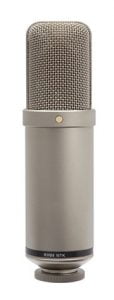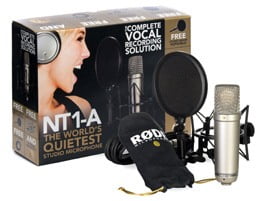Condenser microphones are a staple feature of recording studios. If you want to record voice-overs, singing, or vocal work of any kind, or acoustic instruments where you really want clean sound, Rode has you covered with these two mics. Let’s look at them both to see which is the best for you.
Rode NTK Tube Condenser Microphone

The Rode NTK is a classic tube microphone, perhaps one of the quietest on the market. It has less than 12dBA self-noise so what you record is what you hear without interference from the mic itself. That low self-noise results from the separate and dedicated power supply and the excellent shock mounting of the internal HF-2 capsule. If you need even less self-noise, take a look at the NT1-A below.
With its large 1-inch gold-plated diaphragm, the NTK makes voices and instruments like acoustic guitars sound warmer. But it’s no delicate piece of equipment. This mic can handle a high sound pressure level of 158dB. It won’t buzz out or give feedback even when you’re rapping or recording rock.
Many professionals would agree that the Rode NTK is one of the best tube mics money can buy. Its rich sound comes in part from the hand-selected twin-triode valve. It also has a wide dynamic range in part from its sensitive Class A circuitry that rejects RF interference from other electronic equipment.
The exterior of the NTK looks both beautiful and professional with its satin nickel finish and the high strength steel mesh head. Watch carefully the next time you see artists recording in the studio and see if they don’t have a Rode NTK there.
More features of the Rode NTK Tube Condenser Microphone:
- Comes with power supply, 30-foot cable, stand adapter, and carrying case
- Rode offers a 1-year limited warranty that can be extended to 10 years if you register with them
Rode NT1A Anniversary Vocal Condenser Microphone Package

At first glance, the Rode NT1-A looks similar to the Rode NTK. Their mesh heads are different, as are their bases, but at a glance you could mistake one for the other. The NT1-A is excellent for studio recordings as it has even less self-noise than the Rode NTK. Check it out—it’s rated at only 5dBA compared to the NTK at 12dBA. That’s an astonishingly low number.
The NT1-A is a flat mic because it has a very neutral frequency response. If you do voiceover recordings, this is one of the best microphones you can use. If you sing, the NT1-A will reveal your voice as it really is. It’s a true condenser mic, externally biased.
The NT1-A has a 1-inch diaphragm with a cardioid polar pickup pattern to catch all the action right in front of it. If you wish to record acoustic guitars and percussion instruments, it does just as well with those as it does with vocal work, although it usually comes recommended for voice recordings.
When it comes to rap and rock, the NT1-A can handle high sound pressure levels, but just not quite as much as the NTK. It maxes out at an SPL of 137dB. The interior circuitry is based on a JFET impedance converter with a bipolar output buffer.
The NT1-A comes in a special commemorative package with an external studio grade pop shield, a Rode SM6 shock mount, and a 20-foot long XLR cable. The NT1-A requires 24V or 48V phantom power to operate.
More features of the Rode NT1A Anniversary Vocal Condenser Microphone Package:
- Microphone dust cover and NT1-A Studio Secrets instructional DVD also included in this Anniversary set
- Rode offers a 1-year limited warranty that can be extended to 10 years if you register with them
- Output impedance os 100 ohms
- Frequency range is 20Hz to 20kHz
Recommendation
Both of these Rode microphones are top notch for doing voice recordings and broadcasts in studios.
If you plan to record work with high volume, high sound pressure levels, consider getting the NTK since it can handle up to 158dB.
If you do voiceovers, the NT1-A comes very highly recommended for its low self-noise and neutral sound.
Click here to purchase Rode NTK on Amazon.com!
Click here to purchase Rode NT1A on Amazon.com!